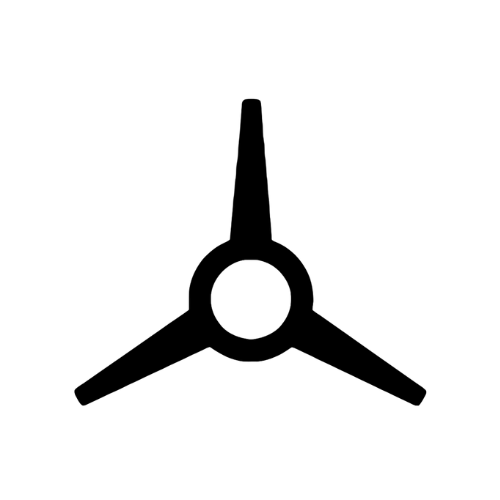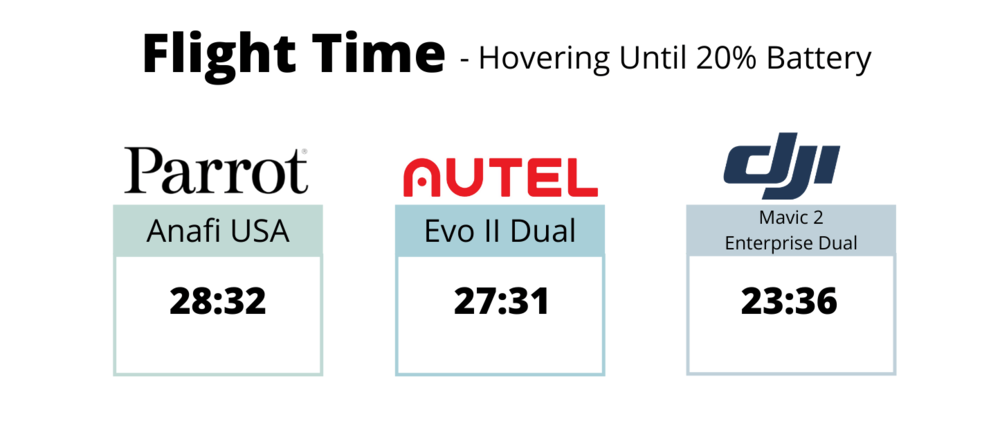TETHERED DRONE VS FREE-FLYING DRONE
A free-flying drone, also commonly referred to as Unmanned Aerial System (UAS) or Unmanned Aerial Vehicle (UAV), has made tremendous technological progress in the last decade, from flight control stability to thermal imaging. As drone capabilities continue to further develop, two main issues still troubles many drone operators today.
Firstly, commercially-off-the-shelf drones can only sustain for a limited flight time. In the market, the average flight time is about 25 minutes.
Fig1. Table of Popular sUAS drone flight time
This leaves drone operators no choice but to manually land the drone and change the batteries before flying it again. This makes flying the drone such a laborious and cumbersome process, especially when your flight mission has to be interrupted. This becomes a huge problem for enterprise drone users, primarily the public safety industries where being mission-oriented is key and that every second matter.
DJI Mavic 2 Enterprise Drone used by Public Safety Teams
Secondly, there are different drone size classes, ranging from 250g to as heavy as 25kg. More often than not, no one wants to carry around a heavy, oversized drone as much as possible. Therefore, a more compact-sized drone, offering the same set of features as its larger counterpart, is always definitely a much preferred choice since it is easily carried, highly portable and much more maneuverable in flight. However, the number of powerful and compact-sized drones are not abundant. An example is the widely anticipated newly released drone, the DJI Mavic 2 Enterprise Advanced.
Drones and UAS have been an essential tool in many industries, but while operation is improved with the help of drones, these issues still largely persist and can undermine the high performance and productivity of drones.
DJI Mavic 2 Enterprise Advanced
Simply plug-and-play, Volarious V-LINE Actively Tethered Drone System is specifically made for the purpose of addressing the biggest frustrations of drone operators. This tethered drone system now makes it a viable option for popular COTS compact-sized drone models to have unlimited flight time. We will have a look at the benefits and drawbacks of having tethered drones as compared to free-flying drones.
In the next article, we will be talking about the various types of tethered drones systems available in the market. Click here to find out more!
Benefits of a Tethered Drone?
Unlimited Flight Time
Within the tethered drone system, the power base station component of the system will harness the power from either a portable AC generator or in-built batteries. The drone is attached to the tether cable, in which power is transmitted from the power base station to the drone.
This results in your drone being fully operational 24/7 if need be. This comes in very useful for prolonged drone operations that require the drone to be up for an extended period without interruption. This includes monitoring and inspection for data analytics, as well as security and surveillance for military personnel and asset protection.Autonomous solution for single-man operator
In the case of the Volarious V-LINE Actively Tethered Drone system, our tethered drone system has an auto-tensioned reel system and options for auto-landing and takeoff. This means the tension of the drone tether cable automatically adjust according to the external environment and length of the tether cable, making the drone or UAS always actively tethered.Without the need for the remote controller for the drone, the operator can activate the smart features such as auto land and takeoff via the V-LINE App on their preferred choice of Android smartphone or tablet. Because of this, not much piloting experience is required. Since a trained pilot is not necessarily required to operate a tethered drone, this makes flying the drones so much easier and make implementing drones into operation more accessible than before. Tethered drone systems allow the drone operators to quickly set up the drone and be focused on their mission, while the tethered drone can continue to hover indefinitely while still providing elevated situational awareness.
Use within no-fly zone set by regulatory authorities
Certain aviation authority bodies mandate the need to use tethered drones in “no-fly” zone such as an aerodrome. This is to eliminate any possibilities for a drone or UAS fly away situation due to drone malfunction since the drone is attached via the tether cable and the length of the tether cable can be fixed to a certain length accordingly for safety and security purposes. In certain countries, drone operators using tethered drone systems would not need to register the drones to the authorities, unlike free-flying UAS, making it easier to implement drones to operations.
Drawbacks of a tethered drone?
Limited to the cable
The tethered drone cannot fly beyond the maximum extension of the tether cable length from the fixed point which the base power station is being set up. Also, the tethered drone would not be able to fly through narrow course or path with many overhead obstacles.
Comparing Tethered Drones with Free-flying Drones
While the tethered drones and the free-flying drones each have their own unique pros and cons, they each serve different purposes and use cases. Tethered drone systems enable people with limited piloting experience to easily and quickly operate the drone and ensure the drones can stay in the air 24/7, making it highly sought after by the surveillance industry, as well as for broadcasting, monitoring and data collection purposes. However, free-flying drones are meant for beyond visual line of sight operation which requires the drones to be dynamic.
To enjoy the best of both worlds, get a tethered drone system that offers a plug-and-play method to easily switch between tethered drone mode to free-flying. Depending on the nature of the operation required, the drone operator can easily switch between the two-mode options to obtain the best possible outcome.




